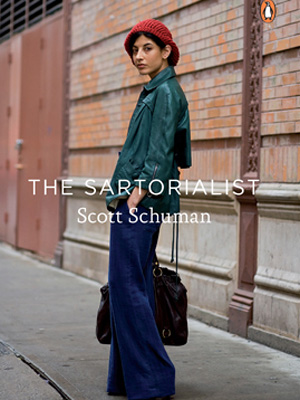
I pre-ordered this book over a month before it came out. I check the blog at least twice a day. I cannot deny that I, like so many others, am obsessed with the Sartorialist. Of course I love the images. But I also love Scott Schuman's attitude. Despite being lauded as pretty much the most influential, most widely-read/viewed, most imitated player in fashion media at the moment - and there's a very good argument for such platitudes being true - he gives out an aura of modesty and humility that makes for refreshing reading. While he undoubtedly has a superb eye for style and a great gift for portrait photography, he is always generous and outward-looking in his commentary, always praising the talents and tastes of others, not himself, and always acknowledging his debt of inspiration to others, and speaking of the joy he gets from what he does and the people his lifestyle allows him to encounter. So Scott, if you're reading this, call me.
My copy of the book arrived in the post today - hooray! After 30 minutes of greedily perusing of the pages, what stood out for me (well, after I'd got over my giddy clothes-induced excitement) was the number of times Schuman brings up, and criticises, particular themes in the kinds of comments that some images had provoked on his blog. For example, next to one image of a very slender young woman, he remarks:
When I posted the picture on the blog, most of the conversation about the shot focused on her weight [...] For me, the image will always be about her stillness, not her weight.
It's common for Schuman to either censor or ask for fewer comments about the body type of his subjects on the actual blog, as any frequent peruser of the comments will have noticed, and that's fair enough: such discussions can easily descend into what read like personal attacks on the subject.
Then, opposite an image of a precociously stylish pre-teen Parisien, Schuman comments:
Unfortunately, when I posted this shot on the blog the majority of comments were about the $1,200 sneakers he was wearing.
His cover star, Julie, receives her own page of commentary from the author:
Often when I post a picture of her she receives comments like, 'Oh, she is sooo perfect, so chic, a modern Audrey Hepburn. Well, she is very chic, but she is far from perfect, physically at least. Julie has one leg slightly shorter than the other, has very slim arms, and walks with a very slight limp. However, she has never let her physical challenges alter her appearance or diminish her presence.
These comments are interesting in themselves as examples of the way in which a photographer and his public can react differently to the same image. This is in part because of what Schuman can know from real life interaction, but we can't glean from a photo (for example, Julie's limp). But it's also clear that Schuman is trying to exclude certain elements from the discussion of his images. For him, it's all and only about the aesthetic. It's about the aura the slender girl gives out, and the pose she stands in, and the image this creates, and nothing more. It's about the way the sneakers look, that's all, and not a question of how much they cost.
But this is tant amount to putting up a barrier to what are, surely, natural and reasonable patterns of thought. Yes, we can appreciate the aesthetics of an image, pure and simple, but it's virtually impossible to be drawn into the story that the image seems to be telling us, and the questions that it raises. When you see a pre-teen kid wearing shoes that cost as much as many people earn in a week, is it really wrong to question the ethics of the decision to buy them for him? When you see a woman who looks underweight, can you really stop yourself from wondering whether she is genuinely under-nourished, and why? I don't think you can, and Schuman doesn't really, either: he often describes his blog as simply not being 'the right place' for that kind of discussion (and discussions of, say, women's body image and the media's role in manipulating it are ones I am sure he would consider as crucial and important). But to try and make his blog and his book a kind of de-politicised space is both futile (as commentator's reactions consistently show) and naïve. There can be no such thing.
It's not as though the editors of fashion magazines can tell women not to feel insecure about their bodies when their pages are full of impossibly slender, Photoshopped-to-perfection models. You can't expect consumers of media to simply switch off those parts of their brains and consume your images in the ways you want to offer them up. And Schuman contradicts his apolitical policy regularly himself, as the final quotation about Julie shows. In this quotation, Schuman is indirectly but clearly speaking out against a culture which discriminates against people whose bodies do not fit the expected mould, making Julie's poise and elegance a politicised symbol of defiance and strength. Yet if he wants to encourage us to see some of his images as positive political statements, he can't logically or fairly criticise commentators who interpret others as more negative statements, be it as examples of overly extravagant consumerism, or the pressure felt by women to conform to certain body types, or anything else.
I'm speechless! I agree 100% with you! :)
ReplyDeleteI saw your blog today for the first time, good job! I love it!
thesingular.blogspot.com